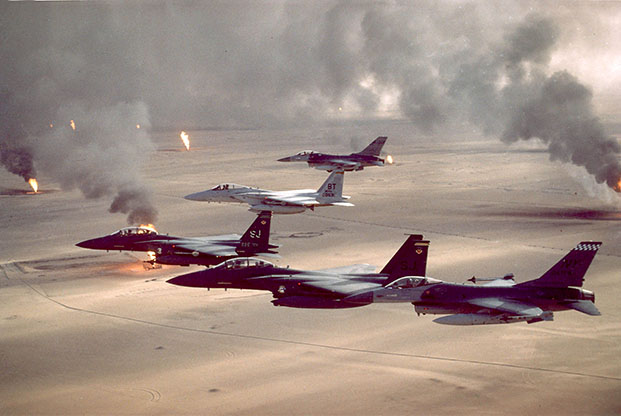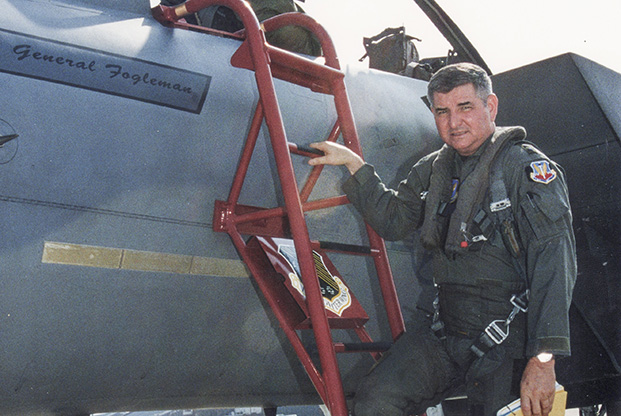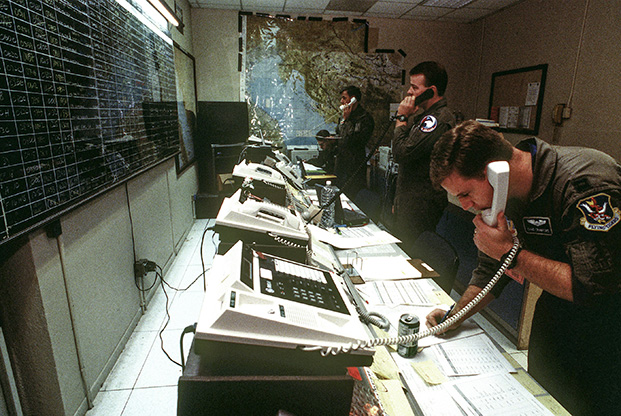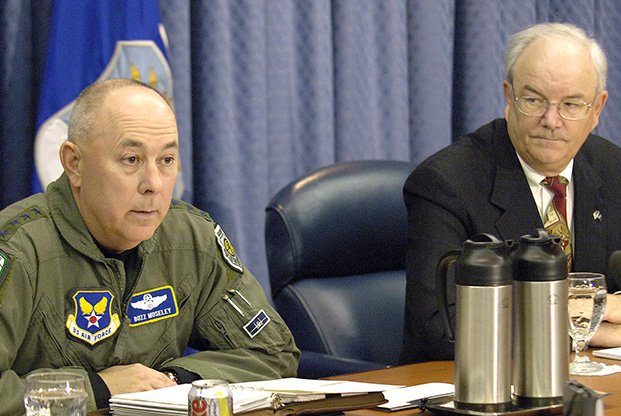 Two USAF F-15Cs, an F-15E, and two F-16s over burning oil fields in Kuwait during Operation Desert Storm. US airpower destroyed Iraq’s command and control operations in less than 24 hours. Photo: USAF
Two USAF F-15Cs, an F-15E, and two F-16s over burning oil fields in Kuwait during Operation Desert Storm. US airpower destroyed Iraq’s command and control operations in less than 24 hours. Photo: USAF
The notion of a “Revolution in Military Affairs” started with the Russians in the late 1970s. Marshal Nikolai V. Ogarkov, chief of the Soviet general staff, was among those who declared that a “military-technical revolution,” later called an RMA, was underway.
As the Russians saw it, advanced technologies—especially “informatics”—and precision strike weapons employed at long ranges were beginning to revolutionize the nature of warfare.
However, the RMA concept was initially based on theory, not combat experience. The first opportunity to make a judgment from the evidence of a significant conflict was the Gulf War of 1991.
Senior military officials in Washington expected the Gulf War to unfold in traditional fashion. In December 1990, they forecast a violent overland struggle, possibly involving the greatest tank battle in the history of warfare. Ground forces were anticipated to be decisive. Airpower would be a supporting element. The Center for Strategic and International Studies predicted 15,000 US casualties. Some estimates ran much higher.
The reality of Operation Desert Storm was far different. Airpower opened the attack at 3 a.m. on Jan. 17, 1991. By dawn, Iraq’s command and control network had been destroyed. A 38-day air campaign left the Iraqi forces reeling, unable to conduct coherent operations. They were finished off in a 100-hour, four-day ground action. Casualties for the allied coalition were 247 dead and 901 wounded, with US losses accounting for about half of the total.
Precision strikes and information superiority set a new standard for effectiveness, making it possible for coalition airpower to hit 150 individual targets the first day. By contrast, Eighth Air Force in World War II struck only about 50 target sets in all of 1943.
In 1992, the Pentagon Office of Net Assessment concluded that the Russians had been right and that a Revolution in Military Affairs was in progress. Regional conflicts in Bosnia (1995) and Serbia (1999) lent further credibility to that conclusion.
The RMA concept included all of the combat arms, but it was increasingly identified with airpower. It was seen as an alternative to the emphasis in traditional warfare on attrition and the clash of force on force. The RMA was recognized by the Joint Chiefs of Staff in 1996 and by the Department of Defense in 1997.
RMA advocates had not reckoned sufficiently with the political power of the Army in the Pentagon. The RMA was a threat to budgets and roles and missions for the ground forces, and the Army struck back, rallying its supporters to the slogan of “Boots on the Ground.”
The issue was not technology. It was airpower. The ground forces could accept airpower in a supporting role but not in the leading or supported role.
Accordingly, the RMA was rolled back. The JCS position was reversed and the Air Force was reminded emphatically that its main role was support of the ground forces.
After the terrorist attacks in New York and Washington, D.C., in 2001, US strategy focused on low-intensity encounters with low-technology adversaries. The emergence of a threat from a military “peer competitor” was of little or no concern. The RMA doctrine was effectively dead.
Two decades into the 21st century, though, the decision to abandon the RMA no longer looks as incisive as it seemed. In 2018, the bipartisan National Defense Strategy Commission warned that the skills necessary for US forces to conduct operations against capable adversaries had “atrophied” and that they might actually “lose a war against China or Russia.”
The National Security Strategy was revised in 2018 with a goal of better responding to “rapid technological advancements and the changing character of war.” It was carefully worded, but it sounded much like the Revolution in Military Affairs.

Gen. Ronald Fogleman prepares to board an F-15 at Langley AFB, Va. Fogleman said the US was obligated to transition to an asymmetric force strategy that could bend an adversary to its will with the least cost of US lives and treasure. He meant airpower. Photo: USAF via AFA library
SIGNS OF A REVOLUTION
The concept of an RMA gained a foothold in the United States when Andrew Marshall, the legendary director of the Pentagon Office of Net Assessment, ordered a major study of the Russian theory in light of the Gulf War experience.
The report, written by Andrew Krepinevich, was published in 1992. It said that a RMA was indeed underway and that “we are probably in the early stages of a transition to a new era of warfare.”
Thomas Ricks, writing in the Washington Post, summarized Marshall’s views in an interview: “Mass armies may be replaced by smaller, more professional forces packing more firepower and fighting from a distance, rather than closing with and destroying the enemy. The main mission of forward ground forces may shift from laying direct fire on the enemy toward spotting targets for ‘standoff’ weapons and assessing the damage they do.”
Adm. William A. Owens, Vice Chairman of the Joint Chiefs of Staff, agreed that an RMA was coming and predicted that it would “lead to a more lethal military with more interservice cooperation.”
The RMA gained additional standing from Operation Deliberate Force, the NATO air campaign in Bosnia, in 1995. The 11-day action consisted almost entirely of airpower and imposed a cease fire on the Serb aggressors in the Yugoslav civil war.
Meanwhile, the Army was showing discomfort with the RMA and sought to discredit the effectiveness attributed to airpower in the Gulf War.
“The recent air campaign against Iraqi forces gained not a single one of the US or UN objectives in the Persian Gulf,” said retired Gen. Frederick J. Kroesen of the Association of the US Army (AUSA) Institute of Land Warfare. “Four days of land combat—aided immeasurably by the air campaign—achieved every goal and victory.”
“Armies are the foundation of nearly all military forces,” declared Maj. Gen. Jay M. Garner, assistant Army deputy chief of staff for operations and plans. “Air forces and navies are ‘add-ons’.”
Conversely, Gen. Ronald R. Fogleman, Air Force Chief of Staff, said in February 1996 that “developments in recent years have given hope that we are on the verge of introducing a new American way of war.”
Fogleman said the nation “has not only the opportunity, but the obligation, to transition from a concept of annihilation and attrition warfare” and “brute force-on-force conflicts” to an “asymmetric force strategy” that could “compel an adversary to do our will at the least cost to the United States, in lives and resources.”
Among the factors making the new American way of war possible, he said, were “the extended range, the precision, and the lethality of modern weapon systems that are increasingly leveraging and leveraged by an agile C4I [command, control, communications, computers, and intelligence] capability that enables war fighters to analyze, to act, and to assess before an adversary has the capability to react.”

USAF airmen at Aviano AB, Italy, coordinate aircraft involved in NATO air strikes during Operation Deliberate Force on Nov. 6, 1995. The 11-day action consisted almost entirely of airpower and imposed a cease-fire on the Serb aggressors in the Yugoslav civil war. Photo: SSgt. Dixie Trawick via National Archives
CONFIRMATION
“Joint Vision 2010,” published in July 1996 by the Joint Chiefs of Staff, took a similar position. “Instead of relying on massed forces and sequential operations, we will achieve massed effects in other ways,” it said.
With precision targeting and longer range systems, it continued, “we should be increasingly able to accomplish the effects of mass—the necessary concentration of combat power at the decisive time and place—with less need to mass forces physically than in the past.”
That struck at the heart of the core capability of land forces, and a JCS expansion of the vision statement in May 1997 went further. It specifically acknowledged a Revolution in Military Affairs that promised to “transform traditional ideas about maneuver, strike, protection, and logistics” and possibly “a complete renovation of the conduct of war.”
The Quadrennial Defense Review, also in 1997, said that the RMA would “fundamentally change the way US forces fight.”
In the spring of 1999, Operation Allied Force in the Balkans compelled the Serbs to withdraw from Kosovo and accept the peace terms dictated by NATO. Airpower was the only force engaged in the 78-day operation.
Nevertheless, that did not keep Army officers away from a different explanation. At AUSA, Lt. Gen. Theodore G. Stroup attributed the victory to the Kosovo Liberation Army, which consisted of about 2,000 irregulars who had been in action for only a few days with no visible results.
Army Gen. Wesley Clark, in overall command of the NATO operation, said the decisive factor was not airpower but rather pressure from the “planning and preparation for ground operations” and the threat of a ground invasion. In fact, NATO had no plans to invade Serbia, and no land invasion could have been conducted for another six months, if then.
 Then-USAF Chief of Staff Gen. T. Michael Moseley and then-Air Force Secretary Michael Wynne were both forced to resign in 2008 by Secretary of Defense Robert Gates for their unwavering commitment to the F-22, which he canceled. Photo: MSgt. Jim Varhegyi
Then-USAF Chief of Staff Gen. T. Michael Moseley and then-Air Force Secretary Michael Wynne were both forced to resign in 2008 by Secretary of Defense Robert Gates for their unwavering commitment to the F-22, which he canceled. Photo: MSgt. Jim Varhegyi
REVERSAL
The backlash was unrelenting. In November 1996, the Army put out is own vision statement that said the contribution of land forces was “to make permanent the otherwise transitory advantages achieved by air and naval forces.”
AUSA’s Kroesen said that “airpower is still a part-time participant that cannot provide the final, decisive action that wins wars.” Retired Army Maj. Gen. Robert H. Scales and retired Marine Corps Lt. Gen. Paul K. Van Riper said that “America’s next war, like those which have preceded it, almost certainly will be won—or lost—on the ground.”
“We are out of the era—if we were ever in it—of airpower being able to cause someone to do something,” said Gen. Gordon R. Sullivan, former Army Chief of Staff and, in 1998, president of AUSA.
Secretary of the Army Louis Caldera said in 1999, “We are committed to making the Army the force of choice of the country,” adding that, “only one service closes with and destroys the enemy.”
“In the final analysis, if you want to radically change the behavior of your opponent, it takes boots on the ground to do it,” said retired Marine Corps Gen. Bernard E. Trainor.
In May 2000, the Joint Chiefs rewrote their vision document, making a complete reversal from their previous position. “Overseas or US-based units will mass forces or effects directly to the operational theater,” they now said.
“The capability to rapidly mass force or forces and the effect of dispersed forces allow the joint force commander to establish control of the battle space at the proper time and place,” the new Joint Vision said. “Beyond the actual physical presence of the force, dominant maneuver creates an impact in the minds of opponents and others in the operational area. … The presence or anticipated presence of a decisive force might well cause an enemy to surrender after minimal resistance.”
The counter-revolution in military affairs was almost complete. What was left of the RMA was destroyed by a series of events and decisions over the next few years.

Two Chinese fifth-generation fighters maneuver during an air show in 2018. Photo: Emperornie
DECAPITATION
The immediate response to the terrorist attacks in 2001 centered on air strikes in Afghanistan, which were effective and successful. Within months, though, the focus shifted to ground operations in Iraq, eventually evolving to an emphasis on counterinsurgency.
There was no part in it for RMA. “We hear many terms, whether it’s ‘transformation,’ ‘military technical revolution,’ ‘revolution in military affairs,’ all indicating something revolutionary has happened,” Van Riper said in a PBS interview. “What I see are slogans masquerading as ideas.”
Ralph Peters, a retired Army officer and widely published military analyst, dismissed the RMA as a “doctrinal cult of the past decade.”
“Wars are won by seizing and holding ground, and only ground forces can do that,” said Deputy Secretary of Defense Paul D. Wolfowitz.
A new Quadrennial Defense Review in 2005 said that irregular warfare was the dominant form of warfare confronting the United States. The 2005 National Defense Strategy listed several “key assumptions,” one of which was that, “We will have no global peer competitors and will remain unmatched in traditional military capability.”
Sen. Conrad Burns (R-Mont.), a former Marine, lectured Air Force leaders at a budget hearing. “The future of the Air Force is in the service to the mission on the ground,” he said. “Waves of Russian fighters will not be coming over the horizon any time soon.”
USAF fortunes sank to a low point in 2008 when Secretary of Defense Robert M. Gates forced both the Secretary of the Air Force and the Chief of Staff to resign. The cover story for the decapitation was failure to ensure security and control of nuclear weapons, but the real reason was what Gates considered to be excessive advocacy of airpower.
Gates was determined to cut the F-22 fighter program radically. “We are fighting two wars, in Iraq and Afghanistan, and the F-22 has not performed a single mission in either theater,” he told a Senate committee.
The two deposed Air Force leaders fought against the F-22 cuts. They also disagreed with Gates when he wanted to divert airmen from their regular specialties and send them to Iraq to guard prisoners and drive fuel trucks.
In 2009, Gates “prematurely canceled the F-22 purchase at less than half the Air Force’s stated requirement to free up funds for wars in Afghanistan and Iraq,” according to a report from the Air Force Association’s Mitchell Institute for Aerospace Studies.
Over the next several years, the Air Force made what was called a “conscious choice” not to aggressively promote airpower, attempting to demonstrate instead that it was “all in” on supporting the ground forces and doing whatever was needed.
“Our most important air and space mission is supporting our troops and those of our allies on the front lines,” Deputy Secretary of Defense William J. Lynn III announced in 2010.
RECONSIDERATION
Scattered doubt began to rise. Even within the ground forces, there was concern that the counter-revolution in military affairs had gone too far.
An internal Pentagon report in 2008 speculated that the Army’s focus on counterinsurgency had weakened its ability to fight conventional battles. Army Col. Gian P. Gentile, director of the military history program at West Point, said that “the US Army has become a counterinsurgency-only force.”
“The current strategy requires the United States to engage in a relatively low-tech, manpower-intensive form of warfare that pits one of its greatest weaknesses against one of its opponents’ greatest strengths,” said Richard B. Andres, professor of national security at the National War College.
Retired Air Force Maj. Gen. Charles J. Dunlap Jr. raised a larger issue.
“Today’s thinking about defense spending is hobbled by the Pentagon’s inability to distinguish sufficiently between the serious challenge of irregular wars and the need to deter truly existential threats posed by nation states,” he said.
The first official break came in revised strategic guidance from Secretary of Defense Leon E. Panetta in 2012. “This country is at a strategic turning point,” he said, calling for a transition “from emphasis on today’s wars to preparing for future challenges.”
However, Panetta’s guidance was motivated mostly by the wish of the Obama administration to cut the defense budget rather than any driving doctrinal conviction. Pentagon officials said they wanted to reduce ground force troop strength by 10 to 15 percent.
In 2014, Panetta’s successor, Chuck Hagel, announced the “Third Offset,” a broad effort to leap ahead of competitors in advanced military technologies. In 2016, the Trump administration phased out the Third Offset language, although many of the concepts continued.
A new National Defense Strategy in January 2018 declared an end to the long fixation on terrorism and small-scale conflicts. “Inter-state strategic competition, not terrorism, is now the primary concern in US national security,” it said. “The central challenge to US prosperity and security is the re-emergence of long-term strategic competition.”
To meet that challenge, the US defense program will have to overcome 20 years of discounting airpower and RMA technology. The Air Force is much smaller than it was in the 1990s, in aircraft as well as in operational squadrons. The erosion has been especially acute in high-end systems. The combined number of F-22 and F-35 stealth aircraft, once projected at 2,144, has reached only 361 so far.
Gen. Joseph F. Dunford Jr., Chairman of the Joint Chiefs of Staff, said that Russia and China had become “near-peer competitors” and that they “can actually challenge our ability to project power and challenge us in all domains.”
The National Defense Strategy Commission—a bipartisan group created by Congress to replace the Quadrennial Defense Review—warned in 2018 that a “crisis of national security” existed. “The US military could suffer unacceptably high casualties and loss of major capital assets in its next conflict,” the commission said. “It might struggle to win, or perhaps lose, a war against China or Russia.”
Whether the culture of the Pentagon can tolerate a doctrine and strategy that addresses that problem remains to be seen.
___
John T. Correll was editor in chief of Air Force Magazine for 18 years and is a frequent contributor. His most recent article, “Team B Tackles the CIA,” appeared in the June issue.